
This worksheet helps students practice creating and identifying correct citations in APA style (7th edition).
- Subject:
- Composition and Rhetoric
- English Language Arts
- Material Type:
- Homework/Assignment
- Author:
- Amy Mallory-Kani
- Date Added:
- 12/23/2021

This worksheet helps students practice creating and identifying correct citations in APA style (7th edition).
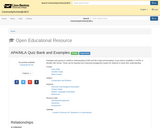
Examples and quizzes to reinforce understanding of APA and MLA style and formatting. A quiz bank is available in XHTML or Moodle XML format. These can be imported into a learning management system for students to check their understanding.
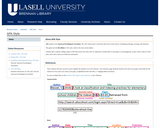
A basic guide to the most common uses of APA style, including color-coded example citations.
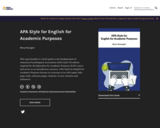
Short Description:
This open booklet is a brief guide to the fundamentals of American Psychological Association (APA) Style 7th edition required for the Education for Academic Purposes (EAP) course and serves as an introductory resource. APA Style for English for Academic Purposes focuses on structure of an APA paper (title page, body, reference page), citations, in-text citations and references.
Word Count: 7036
Included H5P activities: 3
(Note: This resource's metadata has been created automatically by reformatting and/or combining the information that the author initially provided as part of a bulk import process.)
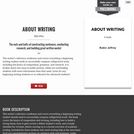
Revised Edition
Short Description:
This writer’s reference condenses and covers everything a beginning writing student needs to successfully compose college-level work, including the basics of composition, grammar, and research. It is broken down into easy-to-tackle sections, while not overloading students with more information than they need. Great for any beginning writing students or as reference for advanced students! Order a print copy: http://www.lulu.com/shop/robin-jeffrey/about-writing/paperback/product-23853977.html
Long Description:
This writer’s reference condenses and covers everything a beginning writing student should need to successfully compose college-level work. The book covers the basics of composition and revising, including how to build a strong thesis, how to peer review a fellow student’s work, and a handy checklist for revision, before moving on to a broad overview of academic writing. Included for those students who need writing help at the most basic level are comprehensive sections on sentence style and grammar, verbs, nouns and other tenets of basic grammar. Finally, the sections on research and citation should help any student find solid evidence for their school work and cite it correctly, as well as encouraging an understanding of why citation is so important in the first place. This is a guide that is useful to writing students of all levels, either as a direct teaching tool or a simple reference.
This revised edition incorporates new sections on revision, citation, and rhetorical concepts. More example text has been provided and the contents have been reorganized to optimize flow and student comprehension. The first edition remains available at About Writing.
Order a print copy: http://www.lulu.com/shop/robin-jeffrey/about-writing/paperback/product-23853977.html
Word Count: 11905
ISBN: 978-1-63635-000-4
(Note: This resource's metadata has been created automatically by reformatting and/or combining the information that the author initially provided as part of a bulk import process.)

A CBU guide
Short Description:
Original version attribution to: Ulrike Kestler. Revised version by: Donnie Calabrese, Emma Russell, Jasmine Hoover and Tammy Byrne.
Word Count: 9554
(Note: This resource's metadata has been created automatically by reformatting and/or combining the information that the author initially provided as part of a bulk import process.)

Word Count: 64590
(Note: This resource's metadata has been created automatically by reformatting and/or combining the information that the author initially provided as part of a bulk import process.)
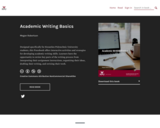
Short Description:
Designed specifically for Kwantlen Polytechnic University students, this Pressbook offers interactive activities and strategies for developing academic writing skills. Learners have the opportunity to review key parts of the writing process from interpreting their assignment instructions, organizing their ideas, drafting their writing, and revising their work.
Long Description:
Designed specifically for Kwantlen Polytechnic University students, this Pressbook offers interactive activities and strategies for developing academic writing skills. Learners have the opportunity to review key parts of the writing process from interpreting their assignment instructions, organizing their ideas, drafting their writing, and revising their work.
Word Count: 6085
Included H5P activities: 8
ISBN: 978-1-9991981-5-2
(Note: This resource's metadata has been created automatically by reformatting and/or combining the information that the author initially provided as part of a bulk import process.)
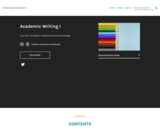
Long Description:
Composition I focuses on principles of writing, critical reading and essay composition using rhetorical styles common in college-level writing (narrative, example/illustration, compare/contrast, cause-and-effect, argument).
Word Count: 59495
(Note: This resource's metadata has been created automatically by reformatting and/or combining the information that the author initially provided as part of a bulk import process.)

Short Description:
Designed specifically for UQ College students, this Pressbook offers interactive activities and strategies for developing academic writing skills. Students will have the opportunity to review key parts of the writing process from interpreting their assignment instructions, organizing their ideas, drafting their writing, and revising their work before final submission. In addition, students will learn key oral presentation skills for both group and individual class presentations and there is the opportunity to also develop students' critical thinking skills.
Long Description:
Designed specifically for UQ College Academic English Tertiary Preparation Program students, this Pressbook offers interactive activities and strategies for developing and refining academic writing skills. Learners are introduced to the writing basics, such as parts of speech, sentence and paragraph structure, right through to writing, editing , and refining their own essay. Students will have the opportunity to review key parts of the writing process from interpreting their assignment instructions, organizing their ideas, drafting their writing, and revising their work before final submission. In addition, students will learn key oral presentation skills for both group and individual class presentations. Also, it offers students the opportunity to develop as critical thinkers and write sound and valid academic arguments. The contents are supported by in-class practice and while it has been designed as an integral part of the TPP Academic English syllabus, it will enhance the writing skills of anyone new to academic writing.
Word Count: 25064
ISBN: 978-1-74272-364-8
(Note: This resource's metadata has been created automatically by reformatting and/or combining the information that the author initially provided as part of a bulk import process.)
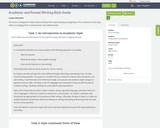
This lesson is designed to help students develop their understanding and application of an academic formal style, while encouraging them to develop their own individual style.
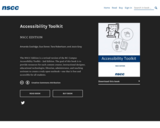
NSCC EDITION
Short Description:
The NSCC Edition is a revised version of the BC Campus Accessibility Toolkit - 2nd Edition. The goal of this book is to provide resources for each content creator, instructional designer, educational technologist, librarian, administrator, and teaching assistant to create a truly open textbook—one that is free and accessible for all students.
Word Count: 13596
ISBN: 978-1-77420-030-8
(Note: This resource's metadata has been created automatically by reformatting and/or combining the information that the author initially provided as part of a bulk import process.)

Short Description:
The goal of the Accessibility Toolkit - 2nd Edition is to provide resources for each content creator, instructional designer, educational technologist, librarian, administrator, and teaching assistant to create a truly open textbook—one that is free and accessible for all students. This is a collaboration between BCcampus, Camosun College, and CAPER-BC.
Long Description:
The goal of the Accessibility Toolkit – 2nd Edition is to provide resources for each content creator, instructional designer, educational technologist, librarian, administrator, and teaching assistant to create a truly open textbook—one that is free and accessible for all students.
This second edition has built upon, and improved, the original toolkit—a collaboration between BCcampus, Camosun College, and CAPER-BC—with a new “Accessibility Statements” chapter, bibliography and list of links by chapter for print users in the back matter, updated information, and corrections to content, style and layout.
The French translation of the first edition of the Accessibility Toolkit—La Trousse d’outils d’accessibilité —is still available. In time, a French translation of this second edition will be made available.
Word Count: 14269
(Note: This resource's metadata has been created automatically by reformatting and/or combining the information that the author initially provided as part of a bulk import process.)

Short Description:
The goal of the Accessibility Toolkit - 2nd Edition is to provide resources for each content creator, instructional designer, educational technologist, librarian, administrator, and teaching assistant to create a truly open textbook—one that is free and accessible for all students. This is a collaboration between BCcampus, Camosun College, and CAPER-BC.
Long Description:
The goal of the Accessibility Toolkit – 2nd Edition is to provide resources for each content creator, instructional designer, educational technologist, librarian, administrator, and teaching assistant to create a truly open textbook—one that is free and accessible for all students.
This second edition has built upon, and improved, the original toolkit—a collaboration between BCcampus, Camosun College, and CAPER-BC—with a new “Accessibility Statements” chapter, bibliography and list of links by chapter for print users in the back matter, updated information, and corrections to content, style and layout.
The French translation of the first edition of the Accessibility Toolkit—La Trousse d’outils d’accessibilité —is still available. In time, a French translation of this second edition will be made available.
Word Count: 14319
(Note: This resource's metadata has been created automatically by reformatting and/or combining the information that the author initially provided as part of a bulk import process.)
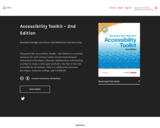
Short Description:
The goal of the Accessibility Toolkit - 2nd Edition is to provide resources for each content creator, instructional designer, educational technologist, librarian, administrator, and teaching assistant to create a truly open textbook—one that is free and accessible for all students. This is a collaboration between BCcampus, Camosun College, and CAPER-BC.
Long Description:
The goal of the Accessibility Toolkit – 2nd Edition is to provide resources for each content creator, instructional designer, educational technologist, librarian, administrator, and teaching assistant to create a truly open textbook—one that is free and accessible for all students.
This second edition has built upon, and improved, the original toolkit—a collaboration between BCcampus, Camosun College, and CAPER-BC—with a new “Accessibility Statements” chapter, bibliography and list of links by chapter for print users in the back matter, updated information, and corrections to content, style and layout.
The French translation of the first edition of the Accessibility Toolkit—La Trousse d’outils d’accessibilité —is still available. In time, a French translation of this second edition will be made available.
Word Count: 14908
ISBN: 978-1-77420-030-8
(Note: This resource's metadata has been created automatically by reformatting and/or combining the information that the author initially provided as part of a bulk import process.)

This guide articulates University Writing's practices for accessibility and inclusivity. We use this guide for internal training within our program.
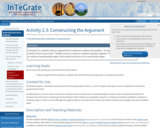
In Activity 2.3, students make an argument from evidence to address the problem: "To what extent should we build or rebuild coastal communities?" Students work as a team to complete a graphic organizer. This task helps them organize an evidence-based position paper. Each student writes his or her own position paper.
(Note: this resource was added to OER Commons as part of a batch upload of over 2,200 records. If you notice an issue with the quality of the metadata, please let us know by using the 'report' button and we will flag it for consideration.)
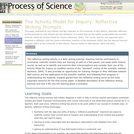
Reflective writing is be a valuable communication tool between instructor and student that fosters critical thinking. When combined with a better model of the scientific method (the AMI) than the "standard" linear model, learners gain a better understanding of the process of science.
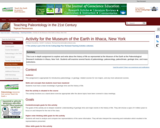
This is an in-depth assignment to explore and write about the history of life as represented at the Museum of the Earth at the Paleontological Research Institution in Ithaca, New York. Students will examine several facets of paleontology: paleoecology, paleoclimate, geologic time, and mass extinctions.

Word Count: 100647
(Note: This resource's metadata has been created automatically by reformatting and/or combining the information that the author initially provided as part of a bulk import process.)